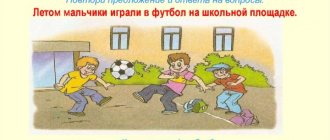Helpful Tips:
- Learning tongue twisters using mnemonic tracks will greatly facilitate this process. The child perceives the word through an image - a picture, model, symbol, sign. And mnemonics are aimed precisely at this - replacing words with images. Even prepositions are denoted by images (you can find models of prepositions below in the article).
- Before you start working with these mnemonic tracks, you need to consolidate the skills of clear pronunciation and distinguishing the sound “Z” in syllables and words. We teach kids to highlight this sound at the beginning, middle and end of words. Coloring pages for the sound “Z” will help you with this.
- All classes on sound automation are based on the principle of simple to complex.
- Each lesson should begin with a warm-up, these are 2-3 articulatory gymnastics exercises.
- Next, we move on to the isolated pronunciation of the sound “Z”, automation in syllables, words, phrases, sentences and other game exercises.
- If the child does not learn or it is difficult for him to complete new tasks, you can go back and consolidate the pronunciation on simpler material.
- When selecting tongue twisters, consider which sounds the child pronounces correctly and which ones he does not. Accordingly, select only those tongue twisters that the child can say correctly, pronouncing ALL SOUNDS . Otherwise, you can not only fail to develop the child’s speech, but, on the contrary, worsen it by reinforcing incorrect pronunciation.
- It is imperative to ensure the correct pronunciation of the sound “Z” when pronouncing a tongue twister. If the child does not succeed, stop him and say this word slowly. Repeat it several times.
- First learn tongue twisters at a slow pace, perhaps syllable by syllable. Gradually increase the pace.
- Pay attention to the clarity of all words for the child. Check with your child to see if he understands all the words; if not, explain their meaning.
Tongue twisters for the development of speech and diction in children 2, 3, 4 years old
Experts believe that children under 3 years of age may not speak at all. If your child is 3 years old and does not speak, contact a neurologist or speech pathologist. Perhaps the delay in speech development is due to some kind of illness.
Possible speech disorders in children 3-4 years old:
- Replaces difficult sounds with easier ones. For example, “ts” to “s”, “r” to “l”. This is quite normal for this age. You just need to talk to your baby more and pronounce complex sounds.
- He puts endings incorrectly because he does not know how to correctly determine cases. For example, I have one coin. For this age, this is a completely acceptable violation.
- Incorrect use of words that are similar in meaning. For example, instead of greedy and stingy, the child says cheap.
- They think for a long time before describing an incident. They go through the right words in their mind. This is the norm.
- At this age, your task is to develop and expand your baby’s vocabulary. Talk a lot, describe objects using new words. Below are tongue twisters for the development of speech in children aged 3-4 years.
Tongue twisters for the development of speech and diction in children 2, 3, 4 years old
Tongue twisters for the development of speech and diction in children 2, 3, 4 years old
Tongue twisters for the development of speech and diction in children 2, 3, 4 years old
Options for games with tongue twisters:
- Find words with the sound “Z” in the tongue twister;
- Find words where in the tongue twister the sound “Z” is at the beginning of the word, in the middle of the word;
- Come up with your own funny sentence using this word;
- Connect the two parts of the tongue twister and pronounce it;
- Say a tongue twister cheerfully, sadly, with fear, quietly, loudly;
- Guess with what intonation your partner pronounced the tongue twister;
- Say a patter and the intonation of a famous cartoon or fairy tale character (for example, the Wolf from Seven Little Goats or Matroskin the Cat from Prostokvashino, etc.);
Tongue twisters for the development of speech and diction in children, younger schoolchildren 8, 9, 10, 11, 12 years old
Children over eight years old have fully formed speech. Children pronounce all sounds well. At the same time, they can construct long and false sentences. The vocabulary is huge. Among the most common problems is poor diction. The child does not speak clearly, mumbles or swallows some words because he is in a hurry. Experiences, stress and nervous shock negatively affect a child’s diction. You need to fight bad diction; there are a lot of exercises and tongue twisters for this.
Diction problems:
- Speech therapists believe that about 30% of the entire world population suffer from diction disorders. This is most often due to the characteristics of speech development and living environment. If one of the parents burrs, stutters, or pronounces hissing words incorrectly, then the child can adopt this feature.
- Most often the problems are with hissing ones. The sounds themselves are pronounced, but articulation is impaired. As a result, there is a violation of diction.
- A large part of poor diction is the mispronunciation of “r”. Most often this is due to incorrect pronunciation and weak muscles. Diction can be improved by training your muscles and pronunciation.
Below are tongue twisters to improve schoolchildren's diction and train their muscles.
Tongue twisters for the development of speech and diction in children, younger schoolchildren 8, 9, 10, 11, 12 years old
Tongue twisters for the development of speech and diction in children, younger schoolchildren 8, 9, 10, 11, 12 years old
Mnemonics of tongue twisters for the sound “Z”:
Tongue twisters for automating the sound “Z” with the help of mnemonic tracks are easier and easier for kids to learn. When a child sees a chain of coherent pictures, he is not so afraid to start learning even complex text. Therefore, use mnemonics to learn tongue twisters. This will make your classes not only useful, but also fun.
Tongue twisters for the development of speech and diction in children using the hissing words Sh, Shch, Ch
This disorder is popularly called a lisp. There are several variants of this disease. Most often, pronunciation defects are associated with deformation of the soft palate, lips or bite. But in children, pronunciation may be impaired due to incorrect positioning of the lips and tongue. In this case, tongue twisters with hissing sounds will help.
Types of lisp:
- Labiodental
- Prizubnaya
- Nasal
- buccal
- Softened
Tongue twisters for the development of speech and diction in children using the hissing words Sh, Shch, Ch
Tongue twisters for the development of speech and diction in children using the hissing words Sh, Shch, Ch
Tongue twisters for the development of speech and diction in children using the sound and letter N
This sound is also usually easy to pronounce. Possible incorrect pronunciation or some distortion. Usually the letter is softened. Below are tongue twisters for practicing the normal pronunciation of the “n” sound.
Tongue twisters for the development of speech and diction in children using the sound and letter N
Tongue twisters for the development of speech and diction in children using the sound and letter N
As you can see, with the help of tongue twisters and articulatory gymnastics, you can correct the pronunciation of some sounds.
Tongue twisters for the development of speech and diction in children using whistling sounds S, Z, C
There are several options for violating the pronunciation of these sounds:
- The tip of the tongue is inserted between the teeth. The result is an unclean “s” and “z” (whispering).
- When the front part of the tongue is in a normal position, the middle part of its back is not lowered enough. The results are softened sya and zy (syanki, zyamok).
- “S” and “z” are replaced by other sounds, often “sh”, “zh”, less often in the younger group “f” to “v” (shapog, zhamok, fapok, vamog). Among toddlers this goes away over time.
- C is replaced by the sounds “s”, “t”, “ch” (saplya, taplya, chaplya).
Tongue twisters for the development of speech and diction in children using whistling sounds S, Z, C
Tongue twisters for the development of speech and diction in children using whistling sounds S, Z, C
Tongue twisters for the development of speech and diction in children using the sound and letter T
Children usually pronounce this sound well. Disturbances are observed in the case of congenital pathologies and with a weak muscular system. In the second case, by strengthening the muscles, you can achieve clear pronunciation of the sound. Below are popular and simple tongue twisters for children of different ages.
Tongue twisters for the development of speech and diction in children using the sound and letter T
Tongue twisters for the development of speech and diction in children using the sound and letter T
Tongue twisters for the development of speech and diction in children using the sound and letter L
Mostly, pronunciation disorders are observed among children aged 3-4 years. At the same time, children pronounce this sound, but it turns out distorted. You often hear “v” instead of “l”. For example, eight, instead of elk. This is due to incorrect articulation and positioning of the tongue and lips. In this case, articulatory gymnastics are more beneficial than tongue twisters. Below are tongue twisters to correct the “l” sound.
Tongue twisters for the development of speech and diction in children using the sound and letter L
Tongue twisters for the development of speech and diction in children using the sound and letter L
Tongue twisters for the development of speech and diction in children using the sound and letter L
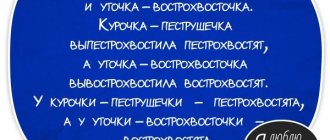
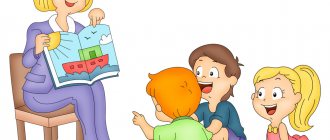
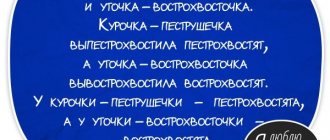

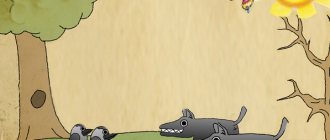

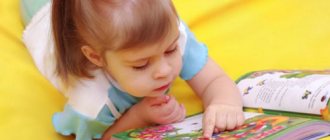
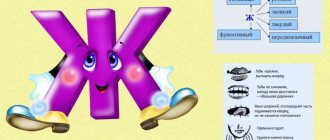
![Visual and didactic manual on sound automation [C] “Interesting cards”](https://lubcentre.ru/wp-content/uploads/naglyadno-didakticheskoe-posobie-po-avtomatizacii-zvuka-s-interesnye-kartochki-330x140.jpg)

